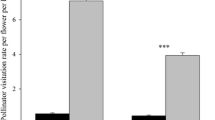Summary
Female reproductive success (fruit and seed set) in Pavonia dasypetala (Malvaceae) was only weakly related to pollinator attentiveness (number of pollinator visits and number of pollen grains deposited on stigmas). This result has implications for field studies of pollination: observational measures of pollinator attentiveness do not necessarily provide an, accurate basis for inferring reproductive success. Further, these results indicate that, although pollination is essential for seed set in this species, reproduction is not limited by pollination. Many flowers that were visited numerous times by hummingbirds and that received pollen in excess of the number of ovules per flower failed to produce fruits. If pollen is limiting, it is pollen quality rather than quantity that is inadequate. Patterns of reproduction in this species were as predicted if resource availability limits seed set (Stephenson 1981): (1) among mature fruits there was an excess of fruits with full seed set (4 or 5 seeds) and (2) probability of fruit, set decreased over the reproductive season. However, resource availability was not the only determinant of seed set in this species: there was also variation among individuals that seems unrelated to either pollen or resource availability. Reproductive success thus appears to be determined by several factors and cannot be described as simply pollen or resource limited.
Similar content being viewed by others
References
Bertin RI (1982a) Floral biology, hummingbird pollination and fruit production of trumpet creeper (Campsis radicans, Bignoniaceae). Am J Bot 69:122–134
Bertin RI (1982b) Paternity and fruit production in trumpet creeper (Campsis radicans). Am Natur 119:694–709
Bierzychudek P (1981) Pollinator limitation of plant reproductive effort. Am Natur 117:838–840
Bullock SH (1982) Population structure and reproduction in the neotropical dioecious tree Compsoneura sprucei. Oecologia (Berl) 55:238–242
Campbell DR, Motten AF (1984) The mechanism of competition for pollination between two woodland herbs. Ecology (in press)
Charlesworth D, Charlesworth B (1981) Allocation of resources of male and female functions in hermaphrodites. Biol J Linn Soc 15:57–74
Cruden RW (1972) Pollination biology of Nemophila, menziesii (Hydrophyllaceae) with comments on the evolution of oligolectic bees. Evolution 26:373–389
Frankie GW, Opler PA, Bawa KS (1976) Foraging behavior of solitary bees: implications for outcrossing of a neotropical forest tree species. J Ecol 64:1049–1057
Gross RS, Werner PA (1983), Relationships among flowering phenology, insect visitors, and seed-set of individuals: experimental studies on four co-occurring species of goldenrod (Solidago: Compositae). Ecol Monogr 53:95–117
Handel SN (1983) Pollination ecology, plant population structure, and gene flow. In: L Real (ed) Pollination biology, Academic, New York pp 163–211
Horovitz A (1978) Is the hermaphrodite flowering plant equisexual? Am J Bot 65:485–486
Janzen DH (1977) A note on optimal mate selection by plants. Am Natur 111:365–371
Leach GJ (1972) Variation in lucerne seed yields in relation to genotype and intensity of pollination. Aust J Exp Agric Anim Husb 12:420–427
Levin DA (1975) Gametophytic selection in Phlox. In: DL Mulcahy (ed) Gametophytic competition in plants and animals, North Holland, Amsterdam pp 207–217
Levin DA, Berube D (1972) Phlox and Colias: the efficiency of a pollination system. Evolution 26:242–250
Linhart YB, Mitton JB, Bowman DM, Sturgeon KB (1979) Genetic aspects of fertility differentials in ponderosa pine. Genet Res 33:237–242
Lloyd DG (1979) Parental strategies of angiosperms. New Zeal J Bot 17:595–606
Lloyd DG (1980) Sexual strategies in plants. I. An hypothesis of serial adjustment of maternal investment during one reproductive session. New Phytol 86:69–79
McDade LA (1983) Pollination intensity and seed set in Trichanthera gigantea (Acanthaceae). Biotropica 15:122–124
Motten AF (1983) Reproduction of Erythronium umbilicatum (Liliaceae): pollination success and pollinator effectiveness. Oecologia (Berl) 59:351–359
Motten AF, Campbell DR, Alexander DE, Miller HL (1981) Pollination effectiveness of specialist and generalist visitors to a North Carolina population of Claytonia virginica. Ecology 62:1278–1287
Mulcahy DL (1974) Adaptive significance of gametic competition. In: HF Linskens (ed) Fertilization in higher plants, North Holland, Amsterdam pp 27–30
Mulcahy DL, Curtis PS, Snow AA (1983) Pollen competition in a natural population of Geranium maculatum. In: CE Jones, RJ Little (eds) Handbook of experimental pollination biology, van Nostrand Reinhold, New York pp 330–337
Mulcahy DL, Mulcahy GB (1983) Gametophytic self-incompatibility reexamined. Science 220:1247–1251
Ornduff R (1975) Complementary roles of halictids and syrphids in the pollination of Jepsonia heterandra (Saxifragaceae). Evolution 29:370–373
Price MV, Waser NW (1982) Experimental studies of pollen carryover: hummingbirds and Ipomopsis aggregata. Oecologia (Berl) 54:353–358
Primack RB, Silander JA (1975) Measuring the relative importance of different pollinators to plants. Nature 255:143–144
Roubik DW (1982) The ecological impact of nectar-robbing bees and pollinating hummingbirds on a tropical shrub. Ecology 63:354–360
Schemske DW (1980) Evolution of floral display in the orchid Brassavola nodosa. Evolution 34:489–493
Silander JA, Primack RB (1978) Pollination intensity and seed set in the evening primrose (Oenothera fruticosa). Am Midl Natur 100:213–216
Snow AA (1982) Pollination intensity and potential seed set in Passiflora vitifolia. Oecologia (Berl) 55:231–237
Stephenson AG (1980) Fruit set, herbivory, fruit reduction, and the fruiting strategy of Catalpa speciosa (Bignoniaceae). Ecology 61:57–64
Stephenson AG (1981) Flower and fruit abortion: proximate causes and ultimate functions. Ann Rev Ecol Syst 12:253–279
Thomson JD, Plowright RC (1980) Pollen carryover, nectar rewards, and pollinator behavior with special reference to Diervilla lonicera. Oecologia (Berl) 46:68–74
Udovic D (1981) Determinants of fruit set in Yucca whipplei: reproductive expenditure vs. pollinator availability. Oecologia (Berl) 48:389–399
Willson MF, Price PW (1977) The evolution of inflorescence size in Asclepias (Asclepiadaceae). Evolution 31:495–511
Wyatt R (1981) The reproductive biology of Asclepias tuberosa. II. Factors determining fruit set. New Phytol 88:373–385
Zimmerman M (1980) Reproduction in Polemonium: competition for pollinators. Ecology 61:497–501
Author information
Authors and Affiliations
Rights and permissions
About this article
Cite this article
McDade, L.A., Davidar, P. Determinants of fruit and seed set in Pavonia dasypetala (Malvaceae). Oecologia 64, 61–67 (1984). https://doi.org/10.1007/BF00377544
Received:
Issue Date:
DOI: https://doi.org/10.1007/BF00377544




